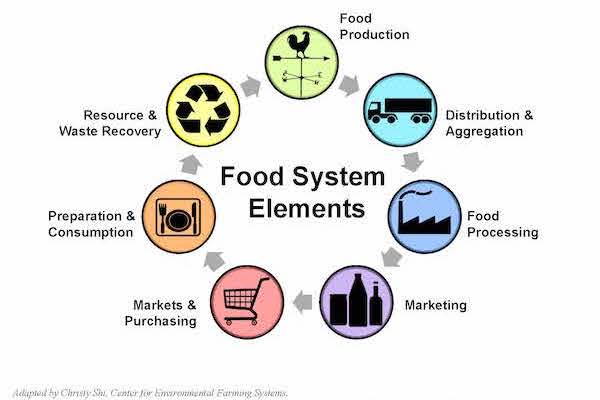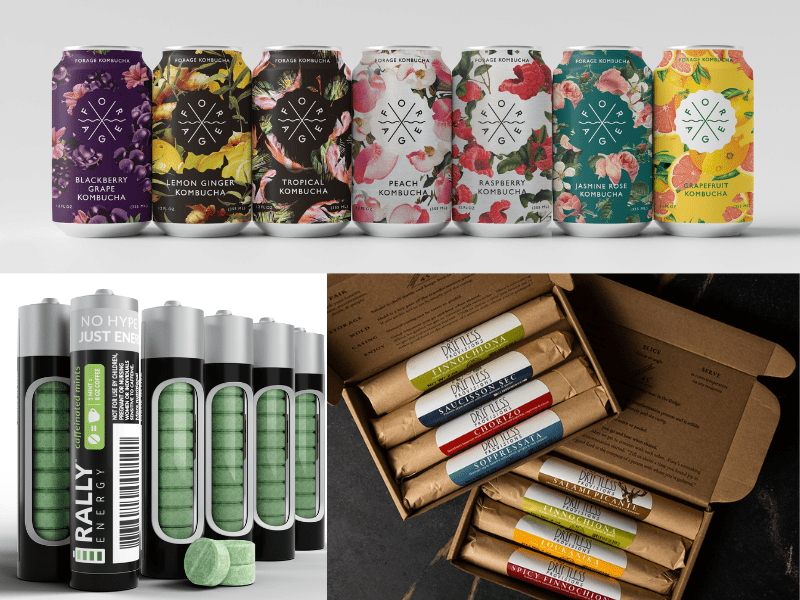Our work in business development for food and farm businesses often intersects with many people who describe themselves broadly as working in food systems, which usually means looking at many different dimensions (not just business dimensions) of how we as people interact with food. And while many private sector food and farm companies look at the social impact of their actions as a business on their communities and the world at large, people who work in foods systems often look as well at the role the government can play in strengthening food systems through incorporating foods systems considerations into their planning and special financing activities.
On our most recent podcast, Sibella Kraus of SAGE about how SAGE revitalizes agricultural places near cities through looking at systemic level actions, like land-use and economic planning, that help protect agricultural lands and livelihoods. She comments on how many of the people working in this way focus on food waste or agricultural production, but less often on the business of food in between production and end consumer. When talking about SAGE, she shows examples of how considering food and agricultural systems as part of the planning process can enhance and support other goals around economic development, while creating an ecosystem that is conducive to food and farm entrepreneurs thriving.
Being part of the University of Wisconsin System, we often think of what role the government and public sector institutions can play in helping build a robust ecosystem of food and farming businesses. Through organizations like ours, the Small Business Development Centers, Women’s Business Centers and others, we certainly support having consultants and educators who are there to assist entrepreneurs with their business development needs, including supporting their fundraising. We also appreciate the role that the government plays in incentivizing more private sector loans (through programs like the SBA7(a) gaurantee program) and through grants like the USDA’s Value-Added Producer Grant which incentivize farm entrepreneurs to show prospects for expanded sales and future investment before applying. This combination of technical assistance and incentives is something we believe can encourage entrepreneurship from the ground up in a more flexible way than top-down government planning.
Sometimes it can be difficult to figure out where multiple actors in the food system can best fit and work together. But, when the private and public sectors work together to speak the same language and align their goals, a lot of good can happen.
And now, our roundup of the best food and beverage finance news, events and resources from around the web…
Business Model Insights
- Should I self-manufacture or work with a co-packer? (New Hope Network) – “Brands looking to grow and enjoy even greater success must weigh whether to continue self-manufacturing or work with a co-packer. Unfortunately, there is no easy answer to whether you should or shouldn’t use a co-packer, nor are there any one-size-fits-all solutions. Your choice will depend on your business goals, the uniqueness and specificity of your product, and your ability to find a trustworthy co-packer that can meet your budget, standards and volume needs.”
- Survive To Thrive (TIG)
- Retailers expect all brands to sell & connect with consumers online (Food Navigator)
 Raising Capital
Raising Capital
- Financials have you confused? Here’s what you need to pay attention to (New Hope Network) – “The window to understanding your future success can lie in the details of your financials. While all aspects of the P&L are important, I think founders need to focus on cost of goods sold (COGS) to ensure that they are not leaving any money on the table. Picking up a few percentage points through more efficiency can lead to greater profit on the bottom line. Additionally, the cost of doing business [sales] is a line item that needs to be managed and flexed when supporting aggressive growth goals and or when needing to preserve cash for other business needs.”
- How to Fund a Food Business for People Who Have No Idea Where to Start (Vice)
- Financing Options for Small Businesses Course (Small Business Administration)
CPG/National Brands
- Brand evolution vs. revolution: Which is right for you? (New Hope Network) – “There is no rule to determine how much of an evolution or revolution your brand needs, but here are some things to consider: What prompted the consideration to change to your branding? Declining market share, relevance with your consumer, visuals and voice not representing the company today, new competitors in the category? Also, if your brand has been around for decades, the equity you have in certain visual elements will be much stronger. For young brands, especially with limited distribution, the equity will be less no matter how great the branding may be. And, since branding is all about connection, it is vital to understand the mindset of your consumer today and how their behaviors are evolving.”
- When Brand And Strategy Are Misaligned, What’s The Remedy? (Taste Radio)
- 6 Ways CPG Brands Can Reach Their Best Audiences (Nielsen)
Market Trends
- SPINS Releases First State of the Natural Industry Report (Project Nosh) – “Natural is thriving, according to a report by data firm SPINS and media company New Hope Network released last week. According to the first State of the Natural Industry report, natural is a major source of growth in the food and beverage business: while overall food and beverage grew only 1.7% year over year, natural grew 5% within the same three year period, reaching $47.2 billion in dollar volume. Additionally, natural food and beverages’ presence in conventional retail increased all three years to reach 9.1% dollar share in 2019, accounting for 27.4% of growth.”
- More people than ever are using food as medicine (Food Business News)
- 3 hot trends on the Expo East show floor (FoodDive)
 Farming and AgTech
Farming and AgTech
- Organic cheerleaders optimistic as growth in popular category slows (FoodDive) – “Sales of organic food in the U.S. last year totaled a record $47.9 billion — 5.9% higher than 2017, according to Organic Trade Association figures released earlier this year. While that’s slower than the 6.4% in 2017, sales continued to outpace the overall food market’s 2.3% growth rate for 2018.”
- Regenerative Agriculture is Having a Moment and 70 Investments Worth $47.5bn are in it (AgFunder News)
- Why do CPG brands need to pay attention to regenerative agriculture? (New Hope Network)
 Deals/M&A
Deals/M&A
- Can alternative protein startups justify their climbing valuations? (AgFunder News) – “For James Joaquin of Obvious Ventures, while Beyond Meat is remarkable evidence that it’s possible to disrupt the trillion-dollar animal protein industry, a startup would need to show a significant R&D advantage and a strong moat against competitors to warrant such numbers. On top of that, he believes that there is danger in raising too much money: ‘one of our favorite lines at Obvious is that most startups die of indigestion not of starvation.’ According to Costa Yiannoulis of CPT Capital, part of the blame should be placed on new investors that have flocked into the sector despite their lack of understanding of the space. He calls it a ‘quality problem to have’ but a problem nonetheless.
- NCN News for August 13, 2019 (Nutrition Capital Network)
- How big name investors can change a brand’s future (FoodDive)
 Industry Events
Industry Events
- Food Business Growth Summit (Tera Johnson speaking) – Free, 9/29 Online
- Natchcom 2019 (Naturally Boulder) – $, 9/30 – 10/4 in Boulder, CO
- Food Culture Forecast (Hartman Group) – $, 9/29 in Chicago, IL
- 2020 Farm Bureau Ag Innovation Challenge (Farm Bureau) – Free to apply, 9/30 Online
- Regenerative Food Systems Investment Forum – $, 9/30 – 10/1 in Oakland, CA
- Good Food Accelerator (FamilyFarmed) – Free to apply, applications due 10/1 Online
- National Direct Agricultural Marketing Summit (Multiple Sponsors) – 10/7 – 10/9 in Rosemont, IL
- Food and Ag Ideas Week (Grow North MN) – $, 10/10 – 10/15 in Minneapolis, MN
- National Farm Viability Conference 2019 (Multiple Hosts) – $, 10/22 – 10/24 in Redwing, MN
- Finance Your Business With Kiva (Madison College) – Free, 10/29 in Madison, WI
- Regenerative Earth Summit (At The Epicenter) – $, 10/29 – 10/30 in Boulder, CO
- Annual Farmer Cooperatives Conference (University of Wisconsin Center For Cooperatives) – $, 11/6 – 11/8 in Minneapolis, MN
- Good Food Financing and Innovation Conference (FamilyFarmed) – $, 11/6 in Chicago, IL
- Business Tax Basics (UW-Madison SBDC) – $, 11/19 in Madison, WI
- MOSES Conference 2020 – (MOSES) $, 2/27 – 2/29 2020 in La Crosse, WI
- National Good Food Network Conference 2020 (Wallace Center) – $, 3/10 – 3/13 2020 in New Orleans, LA




